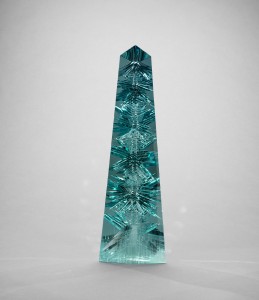The largest single piece of cut gem aquamarine in the world is now on display at the National Museum of Natural History. The Dom Pedro Aquamarine joins a host of famous gemstones — like the Hope Diamond and the Marie Antoinette earrings — in the Janet Annenberg Hooker Hall of Geology, Gems, and Minerals today. It will be displayed indefinitely.
 The aquamarine was mined from a Brazilian pegmatite in the late 1980s and named for Brazil’s first two emperors, Dom Pedro Primeiro and his son, Dom Pedro Segundo. The exceptionally rare gem (in quality, size, color and cut) was gifted to the Smithsonian Institution by Jane M. Mitchell and Jeffery S. Bland.
The aquamarine was mined from a Brazilian pegmatite in the late 1980s and named for Brazil’s first two emperors, Dom Pedro Primeiro and his son, Dom Pedro Segundo. The exceptionally rare gem (in quality, size, color and cut) was gifted to the Smithsonian Institution by Jane M. Mitchell and Jeffery S. Bland.
“There is so much about the Dom Pedro that is remarkable,” said Kirk Johnson, Sant Director of the National Museum of Natural History in a press release, “but what excites me most is that we are able to preserve the story that goes along with it. The Dom Pedro is enriched by all the people and places that have been a part of its fascinating journey from the crust of the Earth to its home here in the National Gem Collection.”
Before cutting, the now obelisk-shaped gem was cut from a beryl crystal which measured 23.25 inches long and weighed nearly 60 pounds. World-renowned gem artist Bernd Munsteiner designed its current shape, standing it 14 inches tall, four inches across the base, and weighing 10,363 carats (4.6 pounds). Munsteiner spent four months meticulously studying the crystal and an additional six months carving, polishing and faceting to create this unmatched work of art.
*Photo credit Don Hurlbert, Smithsonian Institution



![[Vid] A Sneak Peek Inside the New Sixty Vines Foggy Bottom](http://kstreetmagazine.com/wp-content/uploads/2024/04/SV_Wine-176x133.jpg)
